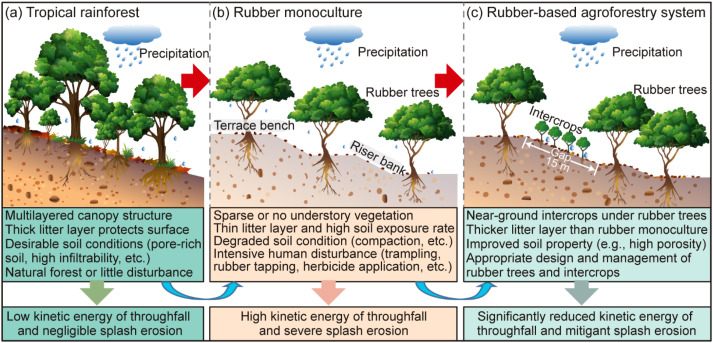
Soil erosion often results in the degradation of ecosystem services and functions throughout the world. Splash erosion is the initial stage of water erosion and directly contributes to the detachment of soil particles on sloping land. As splash erosion is widespread under the intense rainfall of the humid tropics, the gradual transition from large-scale tropical rainforests to rubber monoculture plantations and then to rubber agroforestry systems in Xishuangbanna and similar areas should be underpinned by a better understanding of splash erosion under natural rainfall condition.
In a study published in International Soil and Water Conservation Research, researchers from the Xishuangbanna Tropical Botanical Garden (XTBG) of the Chinese Academy of Sciences monitored the actual splash erosion and its potential controls (rainfall parameters, vegetation structure, litter layer, soil properties) in tropical rainforest, rubber monoculture plantation, and four agroforestry systems in humid tropics, southwest China.
The field monitoring results showed that the intensity of splash erosion was greatly influenced by regime of land use. The disturbed rubber monoculture soil was more vulnerable to splash erosion, and that the transformation of tropical rainforests to rubber monoculture had a negative impact on splash erosion control. The acceleration of splash erosion in monoculture rubber plantations may initiate further water erosion.
The combination of near-ground cash crops with rubber trees significantly improved vegetation structure, ground cover, and soil conditions. These improvements reduced the kinetic energy of the throughfall and the detachability of the soil, thus mitigating splash erosion. Regarding the four agroforestry systems, the intercropping of tea and cacao with rubber trees were more effective in alleviating splash erosion.
Moreover, litter layer removal significantly increased splash erosion under forest canopy. The effect of precipitation on soil splash erosion was stronger under a high single-layered canopy than under a low multilayered canopy. "To mitigate splash erosion, a key concern in land management practice should be the maintenance of forest litter, which shelters the soil surface from erosion," said ZHU Xiai of XTBG.
"For the purposes of erosion control and the sustainable development of rubber plantations, in tropical regions with intense rainfall, rubber/tea and rubber/cacao systems with a low vegetation canopy and a good soil cover are appropriate intercropping patterns," said LIU Wenjie of XTBG.

Effect of land use/cover change on the soil splash erosion in Xishuangbanna, SW China. (Image by ZHU Xiai)

86-10-68597521 (day)
86-10-68597289 (night)

52 Sanlihe Rd., Xicheng District,
Beijing, China (100864)

